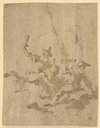Francesco first studied and worked in the workshop of his brother Antonio (1699-1760), his elder by thirteen years, who had taken it over from his father after his death in 1716. There were also close associations with Giambattista Tiepolo, who married Francesco's sister Cecilia in 1719. A major influence was Sebastiano Ricci, whose style was impressed upon him by his brother. Trained as a history painter, Francesco later increasingly specialised in vedute. The first of these were imitative of Canaletto, from whose influence he then freed himself with the commission of the cycle of twelve princely festivals in honour of the doge Alvise IV Mocenigo (1770-1775). In 1782 he was contracted to capture in paintings the festivities on the occasion of the visit to Venice by the 'Conti del Nord', that is, Grand Duke Paul and Grand Duchess Maria Feodorovna of Russia, the later imperial couple - as well as to document the visit by Pope Pius VI. In the final years of his life, he painted, in addition to vedute, mainly landscapes and capriccios with buildings and ruins next to the lagoon. For a long time, Francesco Guardi was known only as a painter of vedute and capriccios. It was only in the twentieth century that he was discovered to have been a history painter as well. Meanwhile a large number of figural depictions, the majority on religious subjects, have been attributed to him. Among his drawings, the majority of which are preserved in Venice's Museo Correr, there are in addition to architectural views and capriccios numerous figural scenes that can be related to many of his paintings.








